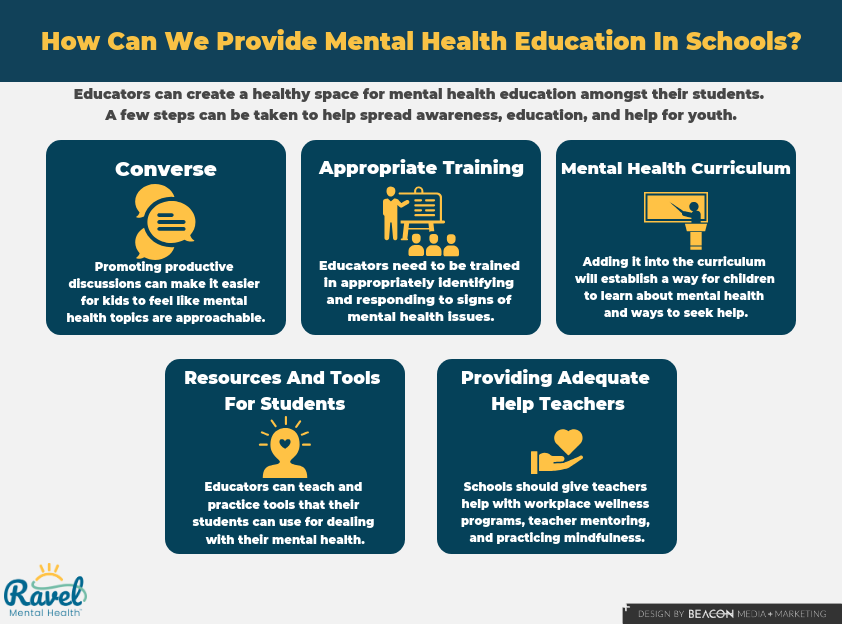Many have seen a surge of adults seeking mental health services. There is a large demand for help, but not enough people to supply it. However, mental health problems have typically been prevalent before they seek help.
Almost half of all mental health conditions begin by the age of 14 and 75% by age 24. Kids can have various mental health disorders, including attention-deficit/hyperactivity disorder (ADHD), behavioral problems, anxiety, and depression. Although signs and symptoms of these conditions occur, many children still aren’t receiving treatment.
So, how can we help them before they reach adulthood? There are many ways that we can change the mental health narrative for youth in the U.S. In this blog, we’ll go over mental health education and how we can increase awareness in schools to provide help when they need it.
Are you interested in helping more kids with their mental health? Sign up for Ravel Mental Health today so you can provide help.
How Many Children Are Struggling With Mental Health?
It’s estimated that one in six children in the U.S. ages 6-17 experience a mental health disorder each year. Yet only about half of youth with mental health conditions have received treatment in the past year.
Undiagnosed, untreated, or inadequately treated mental illnesses can have long-lasting effects on children by interfering with their learning, growth, and development. In 2019, only 15% of adolescents aged 12-17 reported receiving mental health services at school, and only 17% saw a specialty provider.
With so many children living with mental illnesses and not having adequate access to resources, this creates a significant problem. Some may never seek treatment, while others may wait until they are older for help. It’s essential to help them while they’re experiencing their mental illness and aid in the positive growth of their frontal cortex.
Not giving children access to help and destigmatizing mental health will leave them with long-term problems that may never be treated. Schools providing resources and services can help ensure that children are being treated and achieving life goals.
Are Schools Raising Awareness Around Mental Health?
While there isn’t research on how many schools prioritize mental health education, it’s indicated that schools are trying to raise awareness. They are trying to provide trained mental health professionals such as school psychologists, school counselors, social workers, and school nurses. And although there is a gap between need and supply, educators can also help educate their students about mental health.
During the 2017-2018 school year, only about 51% of schools provided assessments to evaluate their student’s mental health disorders. Only approximately 38% of public schools reported giving treatment to their students.
A school-based program aimed at mental health promotion interventions found a substantial impact on their knowledge about mental health after the students went through the course. They also showed a moderate impact on reducing stigma but a weak impact on intentions for seeking help.
This study showed that proper education could help kids be aware of mental illness signs and symptoms and help destigmatize mental health. It shows that we have to find a way to create a desire to seek help when they face mental health challenges.
The significant disparity between mental health services and children in need is alarming. Early identification and effective treatment for children and their families will create a drastic change in their lives to prevent further issues. Untreated or inadequately treated mental illness can have higher school dropout rates, unemployment, substance use, arrest, incarceration, and early death.
Sadly, suicide is the second leading cause of death for youth ages 10-34. Schools that provide training to their staff and students can learn to identify warning signs of emerging mental health conditions. There are ways that schools can increase valuable education around mental health without hiring more help if they’re unable to have a professional mental health provider.
How Can Mental Health Education In Schools Help Kids?
Mental health education can be done in several ways. Educators can make a significant difference by talking about mental health. Children spend a considerable amount of time at school, allowing plenty of opportunities to address mental health problems that could change someone’s life.
Connecting children and their families with school-based mental health services can create an intensive resource for the community. These services can function as a way to break down barriers, so children feel open to treatment and support. Communities of color and other underserved communities can significantly benefit from school services.
Many BIPOC struggle to find mental health professionals that can fit their needs. About 80% of mental health professionals are white, which can become difficult for BIPOC to find culturally sensitive therapy. Providing mental health services through schools in these communities can help reduce dropouts and incarcerations.
Do you want to reach more BIPOC clients? Sign up for Ravel Mental Health today to reach new clients!

How Can We Provide Mental Health Education In Schools?
The high demand for mental healthcare professionals can create problems with obtaining school services. However, educators can create a healthy space for mental health education amongst their students. A few steps can be taken to help spread awareness, education, and help for youth.
Converse
Simply talking about mental health is a great way to bring awareness to students. This can be done through teachers having conversations about mental health, what it can look like, and well-being tips. Promoting productive discussions can make it easier for kids to feel like the topic is approachable.
This can help kids feel more comfortable with reaching out for help. If they know that their teachers are willing to listen to them and help find resources, it can make a difference.
Appropriate Training
Educators need to be trained in appropriately identifying and responding to signs of mental health issues. Teachers can sometimes be the first adult that recognizes signs of distress or crisis. Many teachers feel unprepared to support students directly or refer them to additional services.
Schools can provide in-depth and on-site mental health support services to address every student’s needs comprehensively and effectively. These trainings can help teachers feel more prepared for helping their students.
Mental Health Curriculum
The great thing about addressing mental health is that a whole class doesn’t need to be dedicated to it. It can be integrated into the already established curriculum. For example, English classes can include books that address mental health issues. Then the teacher can help provide examples of what the character should do and give any resources if their students are feeling the same way.
Adding this into the curriculum will establish a way for children to learn about mental health and ways to seek help. It will also aid in destigmatizing mental health so kids don’t feel bad for reaching out for help.
Resources And Tools For Students
Schools may not be able to provide adequate professional help with school counselors with the shortage of mental healthcare professionals. However, they can teach and practice tools that their students can use for dealing with their mental health. This can include:
- Mindfulness about themselves and others
- Relaxation exercises that help reduce stress
- Physical activity that will keep their mind and body healthy
- Producing art (visual, theater, music, etc.)
- Create appropriate break spaces for them to relax
Help Teachers
Teachers already have a lot on their plate with the daily challenges of educating. Having them look out for and teach mental health services can be another difficult task.
Schools should ensure that they are providing adequate help for their teachers with workplace wellness programs, teacher mentoring, and practicing mindfulness. They should also look out for their staff’s mental health and provide services to help them.
How Can Ravel Mental Health Help?
Ravel Mental Health is an online service that allows clients to book appointments directly through the platform. It’s an easy way for clients and providers to connect.
Mental healthcare professionals can use Ravel Mental Health to show their availability for helping youth populations in or out of schools. You can help close the gap between children who need help and the lack of providers.
With a few easy clicks, you can be on your way to helping educators learn more about mental health and connect with kids who are seeking treatment.
Are you ready to make a difference? Sign up for Ravel Mental Health today!
